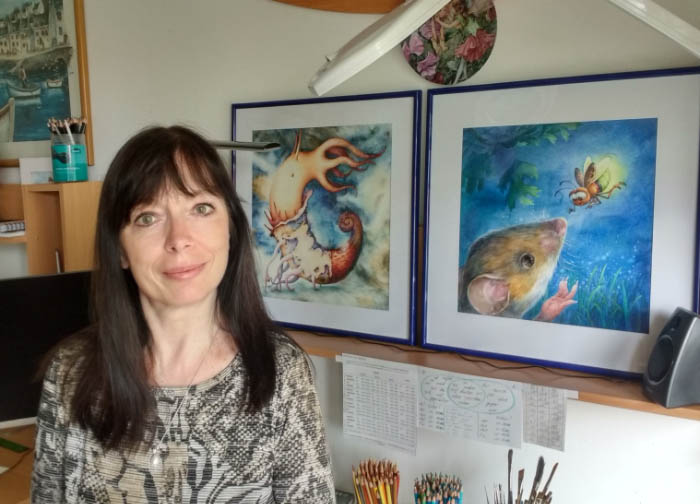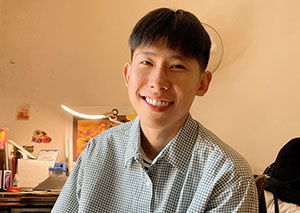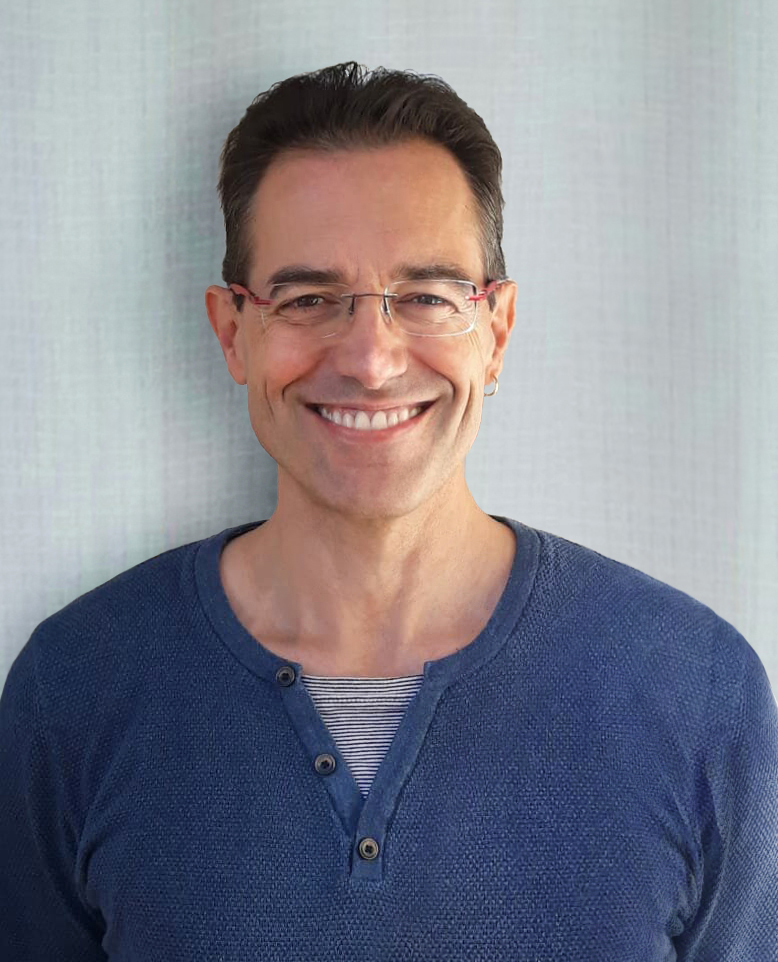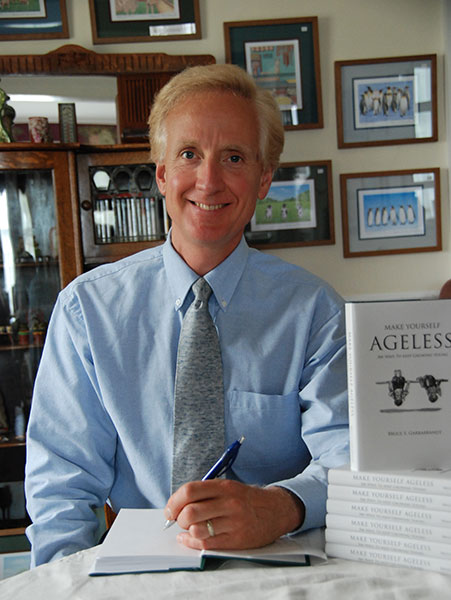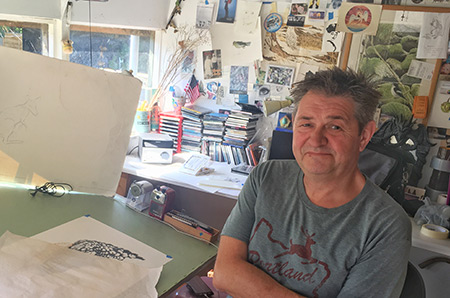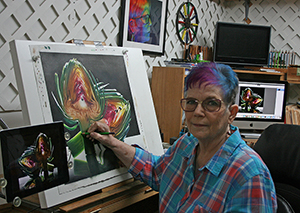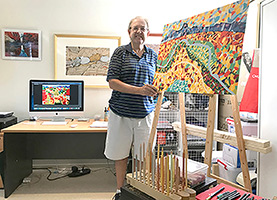
“The Simplicity of Silence” by Armin Mersmann
Pencil on Board, 45” x 80”
Golden Celebration: Part Two
In this second part of the two part Golden Anniversary Interview with Armin Mersmann we are given the opportunity to get to know more about the inspiration behind his incredible artworks.
If you missed the first part of the interview with this great artist, please see this link:
In the following paragraphs we continue where we left off from the first part of the interview, discussing some of Armin’s more recent works; ‘The Simplicity of Silence’ ‘Collapse to Nature’ and ‘Afterflood’.
The Simplicity of Silence:

Mersmann with “The Simplicity of Silence”
Normally one puts their work on a gallery wall and the work needs to carry the power to speak to the viewer, if it’s successful the work will ignite the viewer’s imagination and art is made. The only hint the artist gives is the title in this case “The Simplicity of Silence”.
Ever since getting out of art school years ago, I suspected that talent was a farce, sure there exceptions Mozart, Picasso, Joe Bonamassa and a few others but these are prodigies more so than “talented” people. For the rest of us “talent” is more an unstoppable interest and drive, a work ethic that at times seem almost obsessive. Once this practice gives you a foundation to work on, ideas and concepts make up the rest and none of this comes easy.
A Teacher’s Advice
When my students complain about their art assignments all I have to say is; “suck it up, art is hard, get it done”. Yet time put into an individual project doesn’t mean 1800 hours-that alone has nothing to do with the success of a work. Kate Kollwitz could do with a line in a very short time what 99% of people could never do but it took her years of observation and repetitive technical study to get there.
Personally I have to spend a lot of time on my work to say it in my way; in a nut-shell my fascination is with the complexities of nature, of the human face of a broken light bulb and so on. Simplification is not an interest nor do I feel that I have to avoid it when see a need for it. I go about my work in a simple formula, composition, concept, technique… success is never guaranteed for the viewer has to be moved to fill the artistic circle, after all art is still a form of communication.
The Process
“The Simplicity of Silence” was at times horrendously repetitive, I would sit at the drawing board almost on the verge of hanging it up, but I know at these time I have to rise to the occasion and work thought it. I took no short cuts, I stuck to every branch if they heightened the vision and left out only the ones that took away from the flow.
I have experienced every snow flake every twig and branch every shadow and highlight this is a journey that taking a photo could never give me. Because of this hyper-involvement I hope to share my visions with the viewer in a way that a photo cannot do. This obsessive act translates to the viewer in a completely different manner.
Reality – My Teacher
I’m not interested so much in any particular “ism”, photorealism or hyper-realism per say, but I am interested to show the viewer just how I see my world. Technically I used about one hundred photos as references, I used real branches and twigs that I had in my studio and went to the original place many times, although that changes daily; winter turned to spring, to summer to fall and so on.
What I do not want to do is just copy a photo but translate and reinvent it with my knowledge, imagination and artistic language, the photo is only a map, finding the treasure is within me.
“The Simplicity of Silence” is dedicated to my dad Fritz Mersmann who passed away during this project, he was my only teacher.
Collapse To Nature:

“Collapse to Nature” by Armin Mersmann
Graphite on Illustration board 39” x 31”
It’s not a pretty place nor a sanctuary but a place overgrown and flood damaged. Trees take over in a few years what once was a modern bridge constructed improbably to last. In a short time nature reclaims what man has built. The only evidence that’s left is a concrete slab and a few bricks, the rest gone. Just a memory in the minds of a few old timers of what was.
But why draw this? When I came upon this place I was pulled in instantly; the complexities, the anti-compositional elements of the all-over design, busy, manic, a tempest in wood, yet extremely quiet in its own way more peaceful now than thirty years ago. The day I did the sketches and took the reference photos was the last day of no snow the very next day we received a ten inch snow fall once again blanketing in white evidence of man’s hand.
As a pencil drawing this was a challenge to capture that’s for sure. For four months I drew as manically as the landscape presented itself, a realistic Pollock in a sense. Not a rest for the eye and but a nod to lady nature who in the end comes back to claim.
Afterflood:

“Afterflood” by Armin Mersmann
Pencil on acid free Illustration Board 40” x 30”
This almost kicked my ass, I started it in early April completed it the last day of August.
In the area where I live there is a flood plain, every spring these trees are by and large underwater. I came upon this place when the waters receded. I was blown away by the complex movements of line; limbs, branches, twigs and brambles that seemed to be hanging on for dear life. Because it was this complex I had to draw it, the composition was inspired by one of my heroes Franz Kline. Often abstraction is the catalyst to my compositions, my previous drawing being inspired by Pollock. The unexpected difficulty in drawing thousands of branches weaving over and under, lost lines, found lines and keeping track of all of it was a bit crazy, but rather Zen like at the same time. I worked from life, photos and pieces of twigs that I collected. It was quite the journey.
Requeim II:

“Requeim II” by Armin Mersmann
Pencil drawing 31” x 39”
The struggle here was after I drew the smashed bulbs I liked it as it was, yet in my heart the drawing did not align with my concept. The drawing was not intended to be a “still life” but a symbolic representation of an altar piece and funeral lament. To have left it alone and just crop it wouldn’t have been enough in this particular drawing. I always set out with a goal in mind, this of course isn’t set in stone but I would never have been happy with this work if I didn’t push the envelope. Just the bulbs would have been interesting but safe, I needed to say more.
Depth of Meaning
The bulbs have come to represent a spent life. They once held energy and gave us light to see by, they now are swept aside and discarded like a little known ancestor. Three of course is a very strong number, representing the trinity, birth-life-death and the unity of mind-body-spirit. Not only are there three destroyed light bulbs but also in the alluded grave marker are three stone slabs. The decaying wood cross-member in its process of decomposition makes the horizontal member of a cruciform turning into an altar piece. The wire holding the wood in place unites the two images (bulbs and gravestone).
Spatially my attempt is to make these objects much grander than three small bulbs and a stick but have them creating a wide landscape. These ideas don’t live within one work but are chapters in a concept that are continually being explored within different guises.
Fifty-four Trips Around The Sun:

“Fifty-four Trips Around The Sun” by Armin Mersmann
Graphite pencil 9” x 6”
This is the smallest portrait drawing I have ever done; it’s the size of a hand. Most of my work is huge (four to five foot) I had to really draw in a different manner which took time to get used to. What fascinated me was the hand, I was pinching a black cloth with my thumb and forefinger giving it an almost arthritic look and the bald head was great to draw and l liked the look, but my wife hated it so now I have long hair again.
Through The Iris III:

“Through The Iris: BB Winslow” by Armin Mersmann
Pencil on Arches Paper 18″ x 36″
I know eyes? So far they still fascinate me especially at this scale, my earlier drawings where small at least comparatively to this one. There will be four in the series titled “Through the Iris” (my thanks to 10 years for their continued inspiration). Only three will be shown the first one sold-but three is a better number anyway.
I just love to draw them-they are us, each one of us-without giving credence to the whole face they become universal more than a personal portrait. Also drawing them lets me improve as an observer and draughtsman. My interest is the aging skin and the breadth of textures within the human face that gives a hint of a life lived. The clarity and makeup of the Iris and the multitude of hair on the human face is a fascinating subject, and I have at least one more in me, possibly more.
Breaking Down the Feat
Two will be 18” x 18” this one is 18” x 36” which is very large. They will also answer a host of questions on drawing in this kind of scale for my plan is to draw a 72”x 72” face later on this year.
I used forty to sixty reference photos and a mirror to draw this image taking about 300 hours, although the time element is overrated, it takes what it takes. Thank you to Mr. B. B. Winslow for agreeing to let me age you a bit.
Here is a view of the size of this drawing with myself standing by the work, it is not in a show called “The Anatomy of an Idea: An Invitational Exhibition” at Midland Center for the Arts. I have seven works in the show with fifteen other great nationally known anatomically based artists.

“Through The Iris III” by Armin Mersmann
Pencil on Arches Paper 18″ x 36″
This ends an interesting insight into the mind of a truly great artist. Armin Mersmann is an inspiration and it has been an absolute pleasure to have written this interview in collaboration with Armin to celebrate his amazing accomplishments.
To see more images of his work please go to Armin Mersmann’s website at this link:





